Birds of Florida
Herons and Egrets
Sandhill Cranes, Green Heron, Great Blue Heron, Little Blue Heron, Tricolored Heron, Yellow Crowned Night-Heron, Roseate Spoonbill, Snowy Egret, Great Egret, Cattle Egret, White Ibis, Glossy Ibis
Florida Sandhill Crane - Grus canadensis pratensis
Family - Gruidae
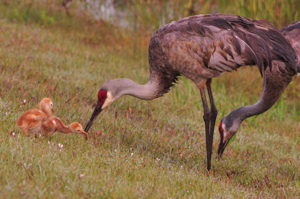
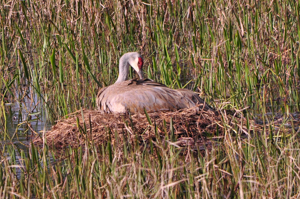
Sandhill Cranes in Florida consist of two groups, there is a native, permanent resident population of cranes consisting of 4-5 thousand individiuals that range from the Okefenokee Swamp in Georgia to the Florida Everglades. The second group - Greater Sandhill cranes (Grus canadensis tabida) migrate here from the northern U.S. and Canada for the winter, but nest in the Great Lakes region.
Sandhill cranes are large grey birds with a long neck and legs, white cheeks and a red patch of bald skin on the top of their head, adults are 3-4 feet tall, have a 6 1/2 foot wingspan and weigh between 7 to 11 pounds.
Natural habitat types are marshes, ponds, and wet praires, they are also seen in pastures, on roadsides,golf courses and residential lawns. Sandhill cranes are omnivorous, with a varied diet consisting of seeds, tubers, insects, worms, grubs, snakes, frogs and even the occasional small mammal.
Sandhill cranes constuct a nest in shallow freshwater marshes from surrounding aquatic vegetation, moss, and grasses into a thick platform that rises above the surrounding water level, laying 1-3 eggs, with both parents contributing to nest building and rearing the chicks. Able to leave the nest within 24 hours after hatching, the chicks stay with the parents for about 9-10 months, foraging with the parents and developing survival skills. Sandhill cranes have lost about 37% of suitable habitat in Florida due to wetland drainage and developement.
I.D. tip - When in flight, cranes fly with their neck stretched straight out, whereas herons hold their necks in an "S" shape.
Green Heron - Butorides virescens
Family - Ardeidae
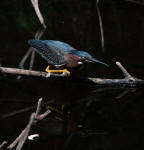
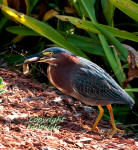
Adult Green Herons have a body length of 19 inches with a wingspan up to 26 inches, also known as the Green-backed Heron, they are year-round residents of Florida. Found in both fresh and saltwater marshes, ponds, lakes and rivers where it fishes the shallow waters by wading or standing motionless on a branch, log or aquatic plants close to the waters surface. Green heronms are unique among herons in that they will drop insects, bits of twigs and other small objects onto the water surface to attract small fish which they then catch with a quick thrust of the beak.
Great Blue Heron - Ardea herodias
Family - Ardeidae
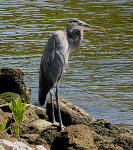

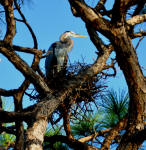
With a wingspan that can be up to six & a half feet across and a body length up to 54 inches long, the Great Blue Heron is the largest heron in North America. Feeding on fish, aquatic invertebrates and the occasional small mammal, they are most often seen stalking prey in the shallows of freshwater rivers, lakes & marshes.
The Great White Heron is a color morph or variation of the Great Blue Heron that was once thought to be a completely different species.
Similar in appearance to the White Egret, Great White Herons are most easily distinguished as having light colored legs whereas the Great Egret's legs are black.
Little Blue Heron - Egretta caerulea
Family - Ardeidae
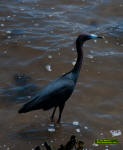
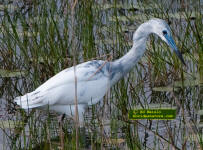
The Little Blue Heron has a body length of 27-30 inches with a wingspan of 40 inches.
Usually seen hunting in the shallow waters of inland waterways, lakes, ponds and marshes, catching fish, amphibians & crustaceans.
The Little Blue Heron will also hunt in grassy meadows for insects and amphibians.
Immature birds have all white plumage, then as the birds mature they take on a mottled or pied appearance, showing both blue and white coloration. Adults are blue and in breeding have reddish-buff colored necks and delicate plumes on their heads with a black tipped, blue bill.
Tricolored Heron - Egretta tricolor
Family - Ardeidae
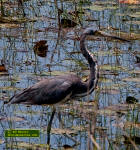

The Tricolored Heron (formerly called the Louisiana Heron) is similar in appearance to the Little Blue Heron.
Tricolored Herons are slate grey with a white stripe running down the neck and white underside, as well as white plumes on the head during breeding season, neck may also be rust colored.
Measuring about 26 inches long, the Tricolored Heron has a wingspan of 36 inches and can be found in marshes, ponds and the shallow waters of rivers where they hunt fish, insects and other small prey.
Yellow Crowned Night - Heron Nyctanassa violacea
Family - Ardeidae
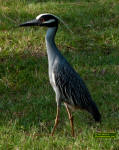

Adult (left), Juvenile (right)
Although it's name implies otherwise this bird is also quite active during daylight hours. The Yellow-Crowned Night-Heron has an average body length of 24 inches with a wingspan of 44 inches.
Adults are slate grey, have a black head, white crown and cheek stripe, reddish eyes and yellow legs. Breeding adults have a yellow fore-crown with white plumes from nape and orange legs.
Juveniles are grayish brown with amber eyes, white spotting and streaks above, gradually acquiring adult characteristics over a two year period.
The Yellow Crowned Night-Heron hunts crustaceans, insects, & invertebrates in Mangroves, fresh and salt water swamps and marshes, mainly near the coast.
Black-crowned Night-Heron - Nycticorax nycticorax
Family - Ardeidae
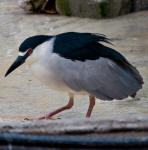
Relatively short and stocky when compared to other Herons, the Black-crowned Night Heron is the most widespread of all Herons, populating all continents except Australia and Antarctica, they are year-round residents within Florida.
Adults are about 25 inches tall with grey wings, white to grey underside, black back and crown. Eyes are red and the legs are yellow-green, except during breeding season when they turn pink. As the name implies, this Heron feeds primarily from dusk to dawn, in doing so it avoids direct competition with other Herons in the same area, which feed during the day.
Roseate Spoonbill - Platalea ajaja
Family - Threskiornithidae
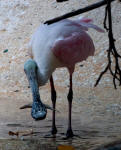
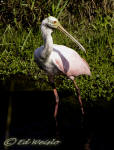
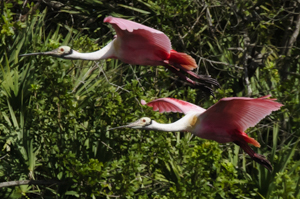
Juvenile Roseate Spoonbills have a white beak, an adults beak is grey. Adults have a bald head with a greenish tinge that turns a buffy golden hue during the breeding phase.
The Roseate Spoonbill with its pink color is sometimes mistaken for the Flamingo, as both birds have a diet which includes the small crustaceans that give their feathers the pink color.
The Spoonbill has a more "stocky" build with much shorter legs, another characteristic that sets them apart from the Flamingo is the difference in their bills, the Spoonbill has a much longer bill that ends with the "spoon" shape, the Flamingo has a short black bill that curves downward.
Spoonbills (much like the Flamingo) feed by sweeping their bill back and forth, probing the shallow waters of marshes, rivers and other bodies of water.
Touch sensitive receptors in their bills allow them to feel their prey in cloudy or muddy water, when something touches these receptors the bill snaps shut, this adaptation also allows them to feed in the darkness of night.
Snowy Egret - Egretta thula
Family - Ardeidae / Subfamily - Ardeinae
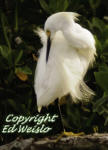
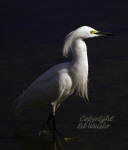
Snowy Egrets can be found in marshes, swamps, ponds, lakes, rivers and tidal flats.
Snowy Egrets were hunted almost to extinction in the late 1800's and early 1900's for their breeding plumes, which were used to decorate ladies hats. They rebounded quickly after being protected under the Migratory Bird Treaty Act of 1918.
The Snowy Egret has a 36 inch wingspan, stands about 2 feet tall and is of slender build, has snow white plumage with a black bill, black legs and yellow feet and lores.
During breeding season this Egret develops long, delicate plumes on their head, neck and back. The yellow parts get a reddish tint during courtship also. Snowy Egrets feed on shrimp, fish, crabs, crayfish, insects, snakes, small frogs.
Great Egret - Ardea alba
Family - Ardeidae / Subfamily - Ardeinae

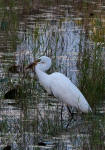
The Great Egret is a large, all white, wading bird common in South Florida. Body length to 39 inches, with a 55 inch wingspan.
One of several white members of the Ardeidae (Heron) family present in Florida the Great Egret is distinguished from the white morph of the Great Blue Heron by having black legs and feet, the Snowy Egret has a black bill and yellow feet and the Reddish Egret, (white morph) which has a black tipped bill and smaller stature. Breeding individuals have long plumes on their backs.
Cattle Egret - Bubulcus ibis
Family - Ardeidae / Subfamily - Ardeinae

The Cattle Egret averages 17-21 inches in length with a wingspan just over three feet. Often observed feeding in open pastures & fields away from water. Follows grazing animals and tractors, feeding on disturbed insects.
Distinguished from the Great Egret & White Heron by its much smaller size and from immature the Little Blue Heron by having an orange bill.
White Ibis - Eudocimus albus
Family - Threskiornithidae
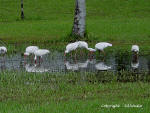
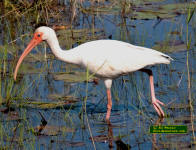
White Ibis are often seen foraging in the wild for crustaceans & frogs, probing mudflats with their long, red, downcurved bill. Alternately, a frequent visitor to golf courses and cultivated lawns, usually in groups.
Adults are all white except for black wingtips, immature birds are a muddy brown with a white belly. The White Ibis has a body length to 26 inches, long legs and bill are red, flies with neck extended.
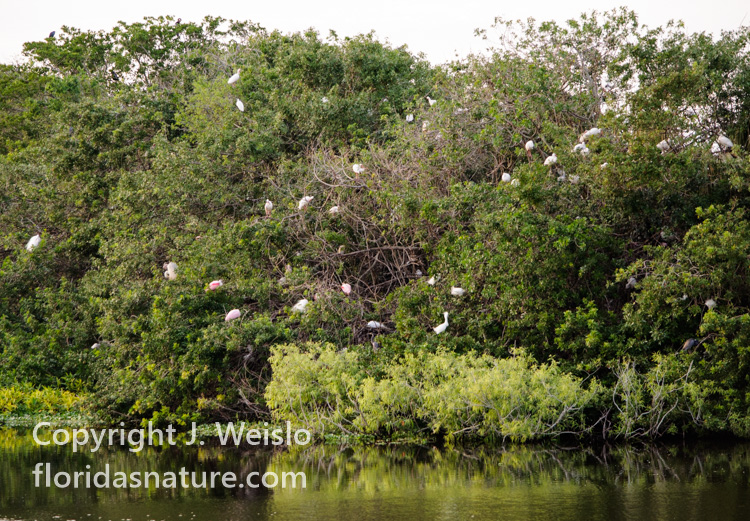
Great Egrets, Snowy Egrets, Woodstorks, Roseate Spoonbills, and White Ibis all share a common roosting place on this Florida marsh "tree island". Funny to watch and listen as the late arrivals squabble trying to settle on to a suitable perch for the night.
Glossy Ibis - Plegadis falcinellus
Family - Threskiornithidae
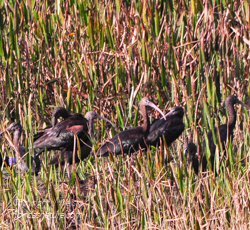
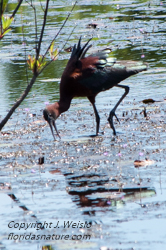
The Glossy Ibis is very common throughout Florida and to a lesser degree along most of the Atlantic coast. This iridescent copper to green colored bird is most often seen feeding in either freshwater or salt water marshes, flooded fields, shallow ponds and other wet areas, probing the shallows and mud for a variety of aquatic insects and insect larvae, small fish, crayfish, tadpoles, frogs, snails, earthworms and even small snakes.
Breeds in colonies, sometimes in association with other wading birds, builds a nest in low shrubs or willows surrounded by marsh or on the ground in cordgrass marshes in dense thickets of shrubs on higer ground or in mangroves.